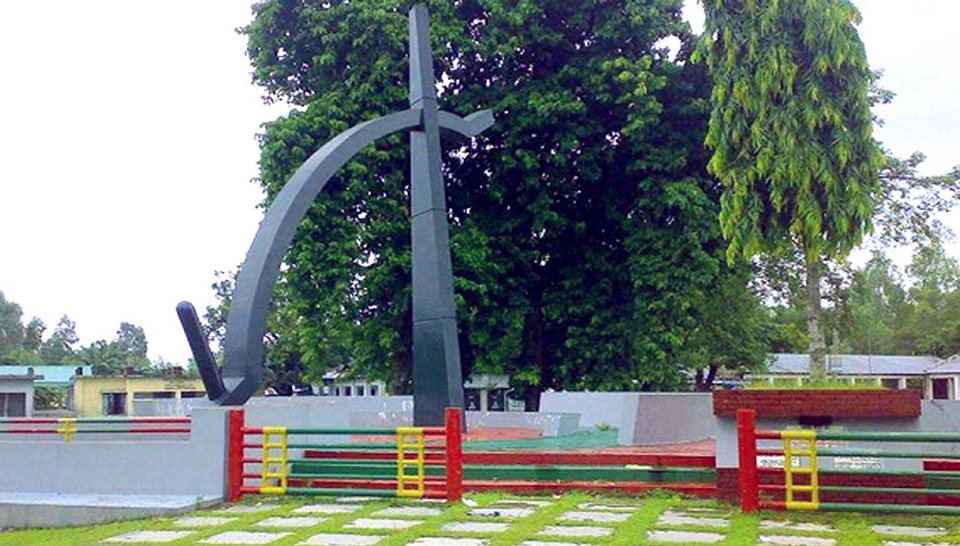
By Mamun Islam
RANGPUR, March 27, 2022 (BSS) - The supreme sacrifice of some 600 heroic
Bangalees while attempting to overrun Rangpur Cantonment on March 28, 1971
remains as a glittering heroism example of Bangalees.
A brave participant in that attempt and valiant freedom fighter Majibar
Rahman Master told the national news agency that the Bangalees showed the
unique bravery only three days after the Pakistani army's crackdown on
innocent Bangalees on March 25, 1971.
"More than 30,000 Bangalees responding to the call of Father of the Nation
Bangabandhu Sheikh Mujibur Rahman attempted to control the cantonment on that
day," Rahman, now 83, said.
According to the famous book 'Juddhe Juddhe Swadhinota' written by Major
Nasir Uddin, a large group of people irrespective of caste, creed and
religion rushed towards Nishbetganj on the Ghagot riverbank in Rangpur city.
"The freedom-lover Bangalee Muslims, Hindus and Buddhists, Oraon, Santal and
other ethnic communities equipped with lethal and sharp weapons, spears,
arrows and bows attempted to capture the cantonment," the book wrote.
It was about 4 to 5 pm when thousands of independence-seeker Bangalees had
been assembling from the south and southwestern areas to overrun the
cantonment at any cost.
At one stage, Awami League (AL) leader Sheikh Amjad Hossain chaired an
unplanned meeting addressed by CPB leader Comrade Sayer Uddin and AL leader
Majibar Rahman Master when thousands assembled at Nishbetganj to march
towards the cantonment
"The 23rd Brigade Headquarters of the Pakistani Army was then stationed at
Rangpur cantonment and the 3rd Bengal Regiment, 26th Regiment and 23rd
Cavalry Regiment and its associate forces and 29th Tank Bahini were under its
command," the book wrote.
War criminal Brigadier General Abdullah Malik was the then Brigade Commander
and the cantonment was equipped with modern automatic heavy arms, artillery,
tanks and ammunition with huge Pakistani forces and non-Bengali Beharis.
The Pakistani army from 10 military jeeps with machine guns soon started
automatic gunfire on the independence-seeker Bangalees that continued for
about five minutes killing some 600 Bangalees and injuring hundreds more.
"The vast green grass fields on the Ghagot riverbanks witnessed the flow of
blood of martyred Bangalees," the book mentioned.
The fearful massacres were committed by the Pakistani occupation army led by
war criminals Brigadier General Abdullah Malik, Colonel Sagir and other
Pakistani Army Officers and their collaborator non-Bengali Behari soldiers
and officers.
Under the command of Colonel Sagir, most of the bodies were collected and
burnt and many bodies and burnt remains were put into the mass grave at
Nishbetganj Baddhyabhumi in the city.
"The incidence was witnessed by Bangalee Officers Major Nasir Uddin,
Lieutenant Badiuzzaman and Lieutenant Hashem, and at one stage, Colonel Sagir
became very angry on them for their silence after the whole genocide was
completed," the book quoted.
Former Rangpur district unit Commander of Bangladesh Muktijoddha Sangsad
valiant freedom fighter Mosaddek Hossain Bablu said the message of dazzling
Bangalee heroism and supreme sacrifice reached quickly to the whole northern
region.
"The political and student leaders immediately began organising the War of
Liberation following the Nishbetganj massacre that ignited a fire in the mind
of every Bangalee," Bablu said.
Captain Nawajesh set up the Headquarters of the EPR Bahini at Kurigram and
started organising resistance against the occupation forces and soon killed
15 Pakistani Army men, including Major Ezaz, at Teesta Bridge frontal battle
in Rangpur.
"The unique heroism and supreme sacrifice of the brave people ignited real
heroism in every Bangalee when they started to join the Mukti Bahini en-masse
in neighbouring India till achieving the Independence on December 16, 1971,"
he said.
In remembrance of supreme sacrifice of the heroic Bangalees, Bangladesh Army
has built Nishbetganj Baddhyabhumi Smriti Soudha 'Rakta Gaurab' where the
grateful people pay rich tribute to the martyrs on March 28 every year.
The district administration and other organisations have taken up programs
including placing wreaths at the Nishbetganj Baddhyabhumi Smriti Soudha
'Rakta Gaurab' tomorrow to pay rich tribute to the martyrs.
Different organisations will bring out rallies bearing indigenous weapons
used while attacking the cantonment followed by gathering of the heroic
freedom fighters and commoners at Nishbetganj tomorrow.